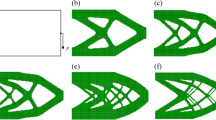Abstract
The traditional topology optimization method aims at finding the optimum design of material distribution. This paper explores the problem formulation and solving approaches to find multiple Diverse Competitive designs for Topology Optimization problem (DCTO). Diversity constraints are used to guarantee the difference between multiple designs. Three graphic diversity measures are presented to set the desired diversity. Four different topology optimization problems including the compliance minimization, the compliant mechanism problem, and the heat conduction problem are used to demonstrate the effectiveness of DCTO. We compare three types of DCTO algorithms for generating four designs and conclude the recommended algorithms. The ranges and effect of the diversity measures are discussed for helping select a reasonable diversity constraint to balance the performance and diversity. Threshold projection and length scale control are also available in the DCTO approach to get a binary solution and avoid small members and holes.















Similar content being viewed by others
References
Andreassen E, Clausen A, Schevenels M, Lazarov BS, Sigmund O (2011) Efficient topology optimization in matlab using 88 lines of code. Struct Multidiscip Optim 43(1):1–16
Bendsøe MP, Kikuchi N (1988) Generating optimal topologies in structural design using a homogenization method. Comput Methods Appl Mech Eng 71(2):197–224
Bourdin B (2001) Filters in topology optimization. Int J Numer Methods Eng 50(9):2143–2158
Chen YH, Zhou SW, Li Q (2010) Multiobjective topology optimization for finite periodic structures. Comput Struct 88(11-12):806–811
Cheng GD, Guo X (1997) ε-relaxed approach in structural topology optimization. Structural optimization 13(4):258–266
Cheng GD, Jiang Z (1992) Study on topology optimization with stress constraints. Eng Optim 20(2):129–148
Danna E, Fenelon M, Gu ZH, Wunderling R (2007) Generating Multiple Solutions for Mixed Integer Programming Problems, Springer, Berlin, Heidelberg
Deb K (1999) Multi-objective genetic algorithms: Problem difficulties and construction of test problems. Evol Comput 7(3):205–230
Deng JD, Yan J, Cheng GD (2013) Multi-objective concurrent topology optimization of thermoelastic structures composed of homogeneous porous material. Struct Multidiscip Optim 47(4):583–597
Duysinx P, Bendsøe MP (1998) Topology optimization of continuum structures with local stress constraints. Int J Numer Methods Eng 43(8):1453–1478
Giachetti A (2000) Matching techniques to compute image motion. Image Vis Comput 18(3):247–260
Hébrard E, Hnich B, O’Sullivan B, Walsh T (2005) Finding diverse and similar solutions in constraint programming. AAAI’05 Proceedings of the 20th national conference on Artificial intelligence, AAAI Press, vol 1, pp 372–377
Marti R, Gallego M, Duarte A, Pardo EG (2013) Heuristics and metaheuristics for the maximum diversity problem. J Heuristics 19(4):591–615
Neves MM, Rodrigues H, Guedes JM (1995) Generalized topology design of structures with a buckling load criterion. Struct Optim 10(2):71–78
Olhoff N, Bendsoe MP, Rasmussen J (1991) On cad-integrated structural topology and design optimization. Comput Methods Appl Mech Eng 89(1-3):259–279
Olhoff N, Niu B, Cheng GD (2012) Optimum design of band-gap beam structures. Int J Solids Struct 49(22):3158–3169
Rozvany GIN (1996) Difficulties in truss topology optimization with stress, local buckling and system stability constraints. Struct Optim 11(3-4):213–217
Seyranian AP, Lund E, Olhoff N (1994) Multiple-eigenvalues in structural optimization problems. Struct Optim 8(4):207–227
Sigmund O (2000) Topology optimization: a tool for the tailoring of structures and materials. Philosophical Transactions of the Royal Society of London Series a-Mathematical Physical and Engineering Sciences 358(1765):211–227
Sigmund O (2007) Morphology-based black and white filters for topology optimization. Struct Multidiscip Optim 33(4-5):401–424
Svanberg K (1987) The method of moving asymptotes—a new method for structural optimization. Int J Numer Methods Eng 24(2):359–373
Wang FW, Lazarov BS, Sigmund O (2011) On projection methods, convergence and robust formulations in topology optimization. Struct Multidiscip Optim 43(6):767–784
Waren AD, Lasdon LS, Suchman DF (1967) Optimization in engineering design. Proc IEEE 55(11):1885–1897
Zhang YC, Liu ST (2008) Design of conducting paths based on topology optimization. Heat Mass Transf 44(10):1217–1227
Zhou YM, Chaudhuri A, Haftka RT, Cheng GD (2014) Global search for diverse competitive designs. In: 5th AIAA/ISSMO Multidisciplinary Analysis and Optimization Conference, Atlanta. Georgia, USA
Zhou YM, Haftka RT, Cheng GD (2016) Balancing diversity and performance in global optimization. Struct Multidiscip Optim 54(4):1093–1105
Acknowledgements
This work was supported by the National Basic Research Program of China (2014CB049000), the National Natural Science Foundation of China (11372062 and 11402049). We thank Krister Svanberg for his MMA program made freely available for research purposes.
Author information
Authors and Affiliations
Corresponding author
Rights and permissions
About this article
Cite this article
Wang, B., Zhou, Y., Zhou, Y. et al. Diverse competitive design for topology optimization. Struct Multidisc Optim 57, 891–902 (2018). https://doi.org/10.1007/s00158-017-1762-9
Received:
Revised:
Accepted:
Published:
Issue Date:
DOI: https://doi.org/10.1007/s00158-017-1762-9




